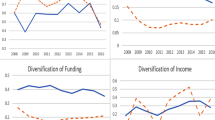Abstract
Scale and scope economies are examined for life insurance agencies that distribute multiple financial products. The results of this study suggest that there are significant administrative returns to scale for firms that sell a mix of financial products. The findings for scope estimates are inconsistent, suggesting that there are positive and negative cost complementaries for pairs of products. Subadditivity can be rejected, suggesting that joint distribution of financial products is not necessarily more efficient than specialization and that different-sized agencies are not necessarily at a cost disadvantage.
Similar content being viewed by others
References
Allen, R. “Cross Sectional Estimation of Cost Economies in Stock Property and Liability Companies.”Review of Economics and Statistics(1974), 100–103.
Baumol, W., Panzar, J., and Willig, R.Contestable Markets and the Theory of Industrial Structure. New York: Harcourt, Brace and Jovanovich, 1982.
Berger, A., Hanweck, G., and Humphrey, D. “Competitive Viability in Banking: Scope, Scale and Product Mix Economies.”Journal of Monetary Economics (3) (1987), 501–520.
Box, G.,and Cox, D. “An Analysis of Transformations.”Journal of the Royal Statistical Association (April 1964), 211–243.
Caves, D., Christensen, L., and Tretheway, J. “Flexible Cost Functions for Multiproduct Firms.”Review of Economics and Statistics 62 (3) (1980), 477–481.
Clapp, J. “Quantity Competition in Spatial Markets with Incomplete Information.”Quarterly Journal of Economics(May 1985), 519–528.
Cummins, J. “Economies of Scale in Independent Insurance Agencies.”The Journal of Risk and Insurance (4) (1977), 539.
Crane, D.B., Kimball, R.C., and Gregor, W.T.The Effects of Banking Deregulation. Washington, D.C.: Association of Reserve City Bankers, July 1983.
Daly, M. Geehan, R., and Rao, P.Productivity, Scale Economies and Technical Progress in the Canadian Life Insurance Industry. Economic Council of Canada, Discussion Paper No. 271, September 1984.
Denny, M. “Measuring the Real Output of the Insurance Industry: A Comment.”Review of Economics and Statistics 62 (February 1980), 150–152.
Denny, M., and Pinto, C. “An Aggregate Model with Multi-Product Technologies.” In M. Fuss and D. McFadden, eds.Production Econimies: A Dual Approach to Theory and Applications. New York: North Holland, 1978.
Fields, J. “Expense Preference Behavior in Mutual Life Insurers.”Journal of Financial Services Research (January 1988), 113–130.
Fuller, W. “Estimating the Reliability of Quantities Derived from Empirical Production Functions.”Journal of Farm Economics 44 (February 1962), 83–99.
Hammond, J., Melander, E., and Shilling, N. “Economies of Scale in the Property and Liability Insurance Industry.”The Journal of Risk and Insurance 39 (1971), 181–191.
Harrington, S. “Operating Expenses for Agency and Nonagency Life Insurers: Further Evidence.”The Journal of Risk and Insurance 69 (June 1982).
Hirshorn, R., and Geehan, R. “Measuring the Real Output of the Life Insurance Industry.”Review of Economics and Statistics 59 (May 1977), 211–219.
Houston, D., and Simon, R. “Economies of Scale in Financial Institutions: A Study in Life Insurance.”Econometrica 38 (November 1970), 856–864.
Kellner, S., and Mathewson, G. “Entry Size Distribution, Scale and Scope Economies in the Life Insurance Industry.”Journal of Business 56 (January 1983), 24–44.
Longbrake, W. “Differential Effects of Single-Plant, Multi-Plant, and Multi-Firm organizational Forms on Cost Efficiency—A Commercial Banking Illustration.” Working Paper No. 74-7, Division of Research, Federal Deposit Insurance Corporation, 1974.
Maddala, G.Econometrics. New York: McGraw Hill, 1977.
Mester, L. “A Multiproduct Cost Study of Savings and Loans.”The Journal of Finance 42 (June 1987), 423–447.
Murphy, N., and Orgler, Y. “Cost Analysis for Branching Systems: Methodology, Test Results, and Implications for Management.”The Journal of Financial Research 5 (Summer 1982), 181–188.
Shepard, R.The Theory of Cost and Production Functions. Princeton, N.J.: Princeton University Press, 1970.
Spitzer, J. “Variance Estimates in Models with the Box-Cox Transformation Implications for Estimation and Hypothesis Testing.”Review of Economics and Statistics (November 1984), 645–652.
Weiss, M. “Analysis of Productivity at the Firm Level: An Application to Life Insurers.”The Journal of Risk and Insurance 52 (March 1986), 49–84.
Weiss, M. “Productivity Growth and Regulation in Property and Liability Insurers: 1976–1984.” Paper presented at the Annual Meeting of the American Risk and Insurance Association, Montreal, Quebec, Canada, August 1987.
Weisbart, S.Extraterritorial Regulation of Life Insurance, Huebner Foundation Studies. Homewood, Ill.: Irwin, 1975.
Zellner, A. “An Efficient Method of Estimating Seemingly Unrelated Regressions and Tests for Aggregation Bias.”Journal of the American Statistical Association 57 (June 1962), 348–368.
Author information
Authors and Affiliations
Rights and permissions
About this article
Cite this article
Fields, J.A., Murphy, N.B. An analysis of efficiency in the delivery of financial services: The case of life insurance agencies. J Finan Serv Res 2, 343–356 (1989). https://doi.org/10.1007/BF00114412
Issue Date:
DOI: https://doi.org/10.1007/BF00114412




